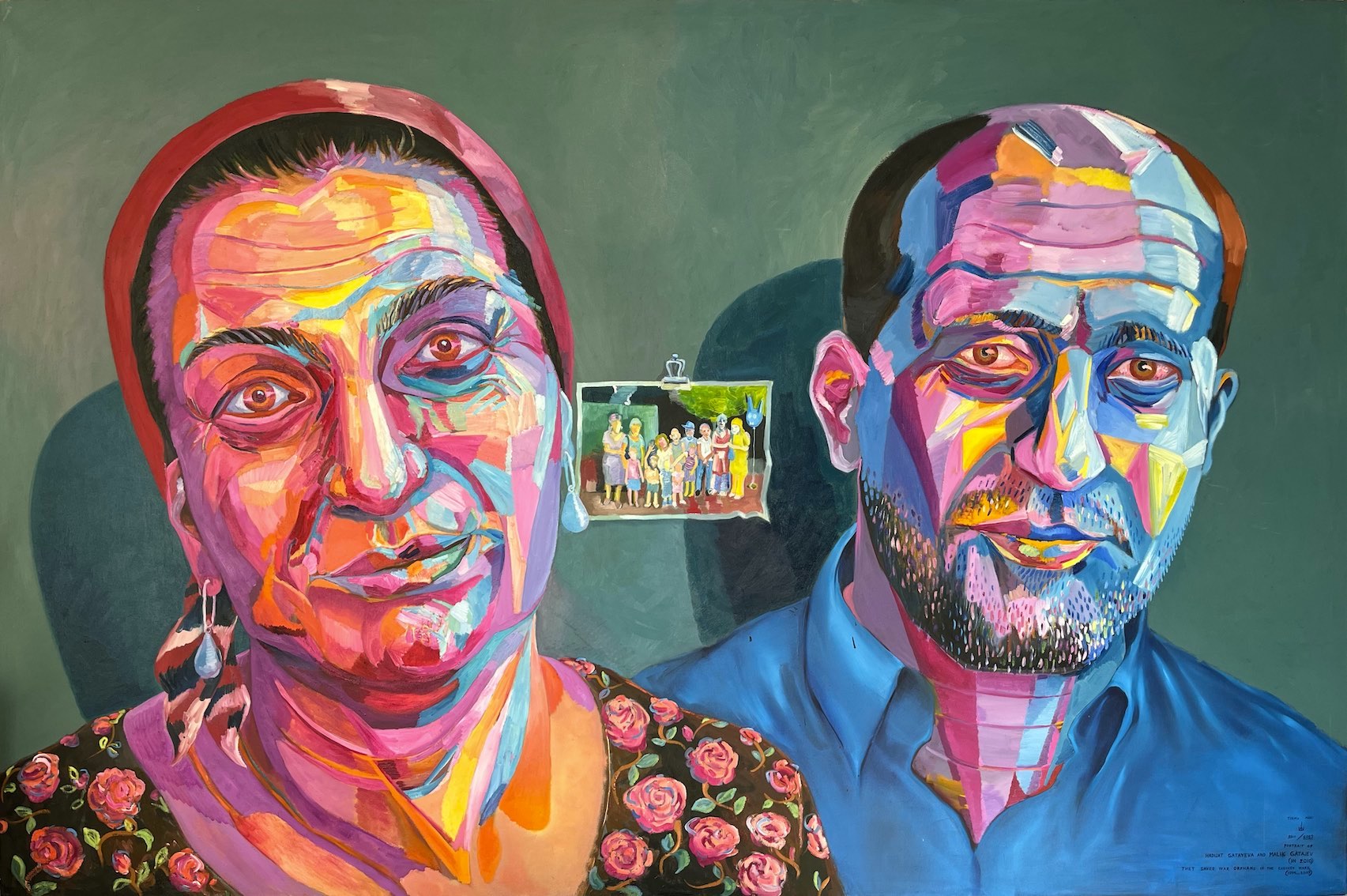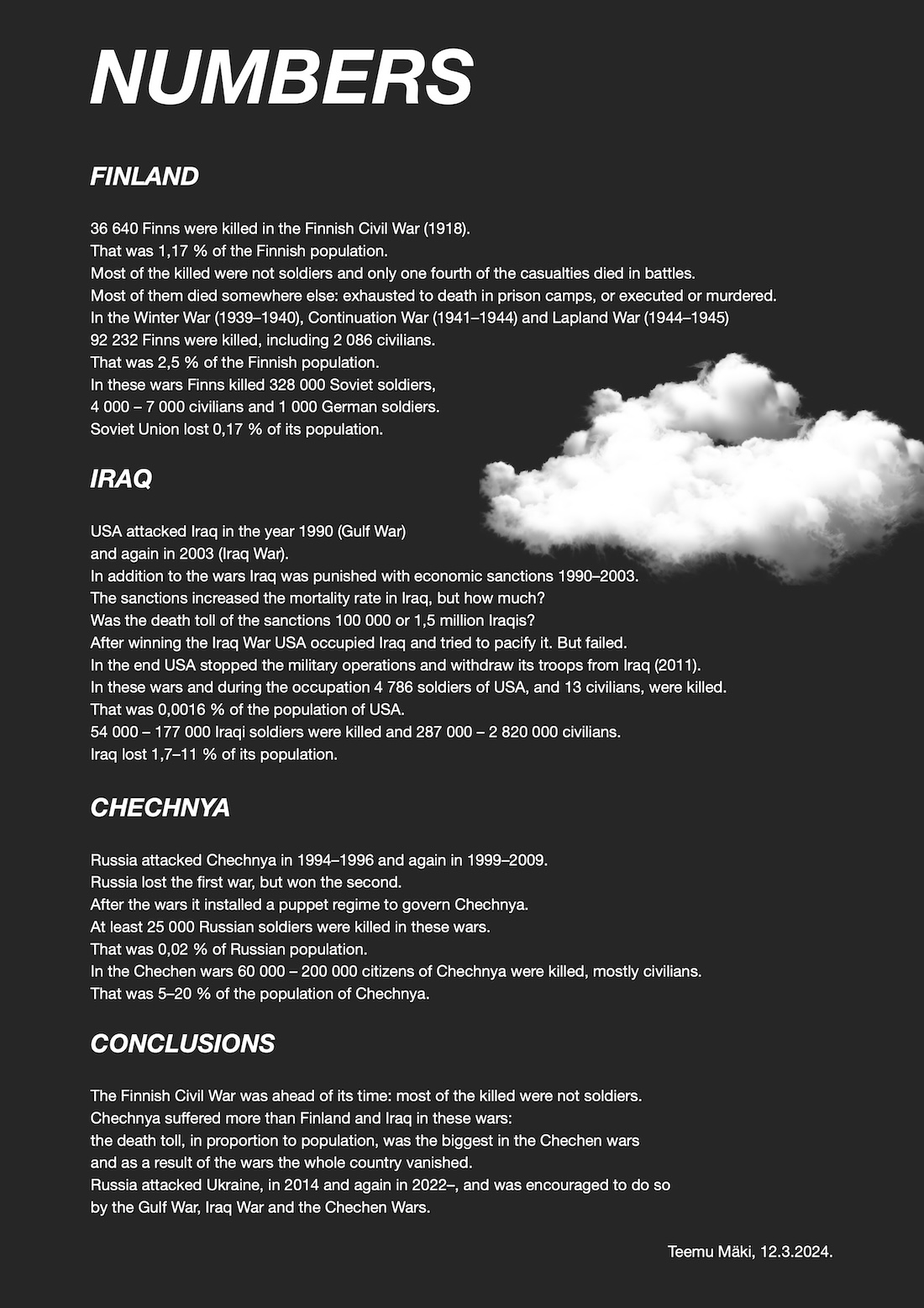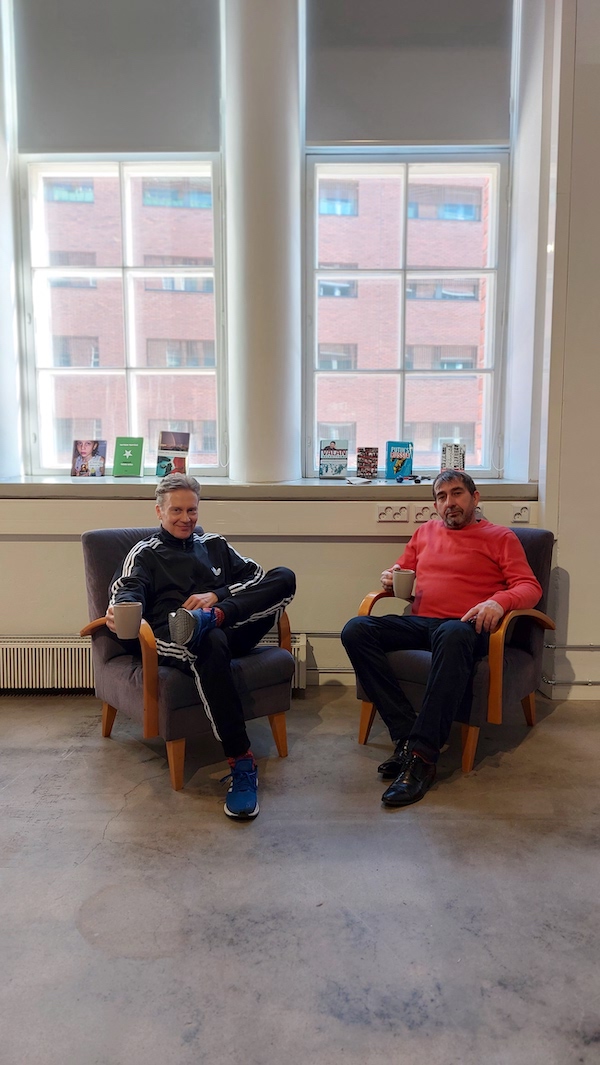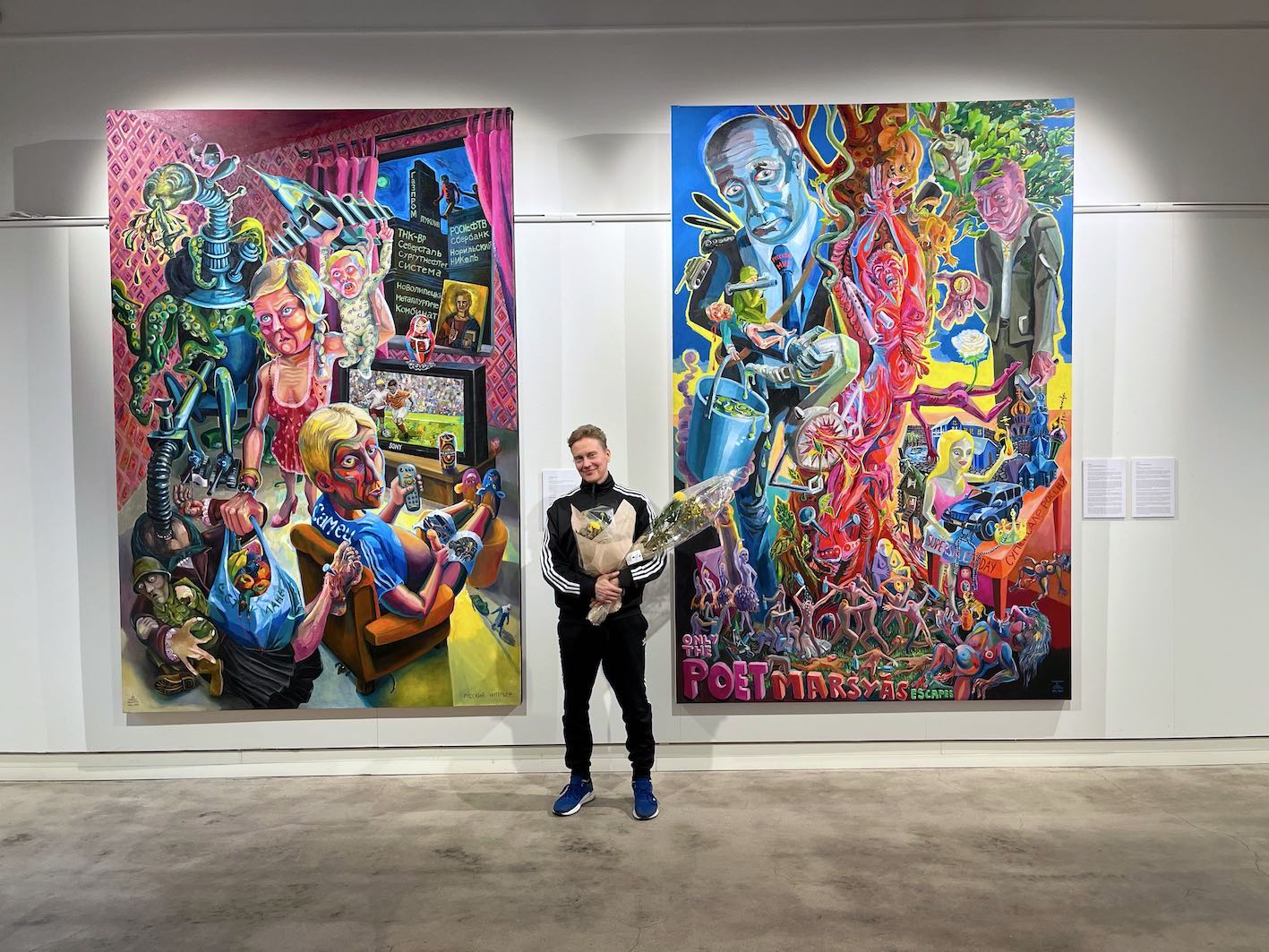DO YOU REMEMBER CHECHNYA?MUISTATKO TŠETŠENIAN?TEEMU MÄKI Exhibition opening Wen 5.4.2023 5–6.30 pm. 6.–29.4.2023 Cultural Centre Caisa’s Gallery Kaikukatu 4 B • Ekogatan 4 B, 00530 Helsinki, Finland |

| ABOUT MY EXHIBITION The theme of the works in the show is the Chechen wars and the Chechen refugees, who fled the wars and persecution. Some of them escaped to Finland. How are they doing now? I've worked on this theme, on and off, since 2008. At the moment the topic is in my opinion especially relevant, because Putin's Russia is trying to do in Ukraine the same it did earlier in Chechnya. I'm exhibiting paintings and texts. The most recent is the portrait of Hadijat Gatayeva and Malik Gatajev, which I completed at the end of March 2023. The earliest works in the show are collective paintings about Chechnya and Russia, which I made with my then students over ten years ago. The students were: Teo Ala-Ruona, Elisabeth Buzet, Sanna Halme, Hanna Peräkylä, Maria Petrova, Hannele Rosenbröijer, Sofia Tarassenko, Matti Vainio ja Janne Vasama. One of these is the painting called Grozny Street Scene / Katunäkymä Groznyissa. It's difficult to deal with war, refugees and violence by the means of art, because pain cannot be shared — unlike for example joy can. One can nonetheless try, because there are many encouraging examples in the history of art. For example Francisco de Goya (1746–1828) and Otto Dix (1891–1969) did cover this type of topics with great success. They made paintings and prints, which in my opinion are as touching and increase understanding and encourage thinking as much as for example Claude Lanzmann's (1928–2018) documentary film about holocaust, Shoah (1985), does. I've dealt with war and refugees for example in the documentary films RIVERBULLS — a Letter to Vladimir Putin (2023) and Refugee Conversations (2020). This time I'm approaching the subject mainly be the means of painting. I think tha painting — or poetry — are equally valid methods for also these topics as more "fact-based methods". Philosopher Theodor Adorno (1903–1969) once quipped in his lecture that "It's barbaric to write poetry after holocaust." Later, in his book Negative Dialektik (1966) he however adjusted his view: "Perennial suffering has as much right to expression as a tortured man has to scream; hence it may have been wrong to say that after Auschwitz you could no longer write poems. But it is not wrong to raise the less cultural question whether after Auschwitz you can go on living." I think it's still good to ponder upon this. And also to keep on writing poetry, by some new way. What about this: is it good for a white, well off Finnish geezer to choose the Chechen Wars, the Iraqi Wars and refugees as the topic of his art? Would it be better to leave these themes for the Chechens, Iraqis and refugees themselves — to those who have first hand experience of the matter and whose voices are less often heard? There is no simple, good, answer to this question. On one hand it's good to make room for the voices and art of those, who are in a weaker position. On the other hand everyone does have the right to speak about any topic they want. Thirdly: you can see some things differently and more clearly from the outside than from the inside. I've often made art, where the theme is refugees or some other group of people that I'm not a member of and who are in a position that's weaker than the average. Sometimes I've made these works on my own and sometimes with for example refugees or some other people who have first hand experience of the matter. I've not been to war and I cannot know what it's like to be a refugee, but I can ponder upon it. And these works are not just about them, but equally about me, i.e. about my relationship to them: what do I think about refugees and distant conflicts, how my own society has reacted to them and in what ways I have contributed, directly or indirectly, to these wars and other conflicts that have made some of us refugees? What must changes? How do I myself want to change? There are also texts in the exhibition. I designed them as posters. The style of the texts varies from statistical digest to poetry. I wrote a couple of them myself and interviewed Ruslan Kantayev, who is a Chechen living in Finland. The other writers are Raisa Foster (Docent, University of the Arts Helsinki), Juha Mäkinen (Docent, Finnish Defence University) and Laura Puumala (Doctoral Candidate, University of Turku, Finland). Foster/Mäkinen/Puumala came aboard, because we are together in a research project that combines science and art. The name of the project is Ympäristösota / Environmental War and its theme is the relationships between wars and environmental crisis. The texts are a part of my exhibition, not bonus or peripheral material. My goal is that this time the exhibition-shaped artwork would speak both the language of factual texts and poetry and pictures. And that this entity would be more than the sum of its parts. Many works in the exhibition deal with grim topics. But one of the wonders of art is that an artworks that's about grim topics can nonetheless be somehow liberating and enjoyable to experience. Where can the enjoyment come from in the midst of bleak themes? Understanding and compassion are forms of enjoyment. Welcome! Helsinki, 4.4.2023 Teemu  LIST OF WORKS The paintings and texts in the exhibition are extracts from a multipartite work called Chechnya in Putinist Russia, which I’ve been working on, from time to time, since 2008. I’ve exhibited parts of the work in many exhibitions, but the complete work has never been shown. PAINTINGS Grozny Street Scene / Katunäkymä Groznyissa by Teemu Mäki & Sanna Halme, Maria Petrova, Sofia Tarassenko, Janne Vasama. 2012. Oil on canvas. 200 x 300 cm. The painting is fictitious, but the situation depicted in it did happen. There is plenty of confirmed info about the war crimes the Russian army committed in the Chechen wars. Portrait of Hadijat Gatayeva & Malik Gatayev (in 2010), They Saved War Orphans in the Chechen Wars 1994…2009. by Teemu Mäki 2011 / 2023. Oil on canvas. 200 x 300 cm. Hadijat Gatayeva and Malik Gatayev, also known as ”the Angels of Grozny” are a Chechen couple, who started an orphanage in Grozny, in 1995, during the first Chechen War. During the second Chechen war they fled with the children to Lithuania. There they were charged for blackmailing the orphans. The accusations were obviously unfounded, but they were given prison sentences. Only after a lengthy court process the sentences were reversed and Hadijat and Malik released. They moved to Finland with their children and were given asylum here. Pirjo Honkasalo made a documentary film about Hadijat, Malik and their work, The 3 Rooms of Melancholia (2004), ja Norwegian journalist/writer Åsne Seierstad wrote a book about them, Angel of Grozny: Orphans of a Forgotten War (2007). In Finland especially Voima magazine has reported on the hardships and happinesses of Hadijat and Malik. Russian Interior / Venäläinen interiööri by Teemu Mäki & Elizabeth Buset, Sanna Halme, Hanna Peräkylä, Maria Petrova, Hannele Rosenbröijer, Sofia Tarassenko, Matti Vainio. 2011–2013. Oil on canvas. 200 x 300 cm. An allegorical painting. A well-off Russian family lives in the security of their own home, enjoying consumerism and escapist entertainment. At the same time elsewhere a war is going on, a war that they unknowingly support and finance. They try not to think of it, but fragments of it are leaking into their cocoon. Contemporary Western viewers should not think that they are totally different from the Russian conformists depicted in the painting, as we are doing the same thing to many others — maybe not as blatantly, but at least as efficiently. Marsyas (Only the Poet Marsyas Escapes) by Teemu Mäki & Teo Ala-Ruona, Elisabeth Buzet, Sanna Halme, Hanna Peräkylä, Matti Vainio. 2011 / 2023. Oil on canvas. 300 x 200 cm. Marsyas is a character in ancient Greek (and Roman) mythology. He is one of the satyrs, spirits of nature. Satyrs have ears that resemble ears of a horse, sometimes also hooves, and a permanent erection. Satyrs are companions of Dionysos. Dionysos — Bacchus in the Roman mythology — is the god of grape harvest, wine, fertility, ecstasy and theatre. Marsyas finds a flute that god Athene has thrown away. It’s a double reed called aulos and Marsyas learns to play it superbly. He is so bold that he dares to challenge someone above him, the god Apollon, into a musical contest. Apollon (Apollo, in roman mythology) plays the lyre and is the master in it. They both play really well in the competition: Marsyas enchants the audience with his intoxicating, frenzied music, while Apollo’s music is full of harmonious beauty. However, in the end Apollon wins. Why? In some versions of the tale he wins simply because he is a bod and Marsyas is beneath him, a mere natural spirit or goblin of the forest. But there are also other versions of the tale and in some of those Marsyas is about to win the contest, but then Apollon resorts to some unfair trick. Apollon may for example in addition to playing start to sing and Marsyas doesn’t have that skill. or Apollon may play the lyre upside down and with this unmusical trick he wins over the audience — especially since Marsyas cannot respond, since the flute can’t be played backwards. All the versions of the tale end the same way. After winning the contest Apollon ties Marsyas to a tree and flays him and hangs his skin from a branch of a tree. What is the metaphorical meaning of the tale? There are many interpretations. At one end there are those, according to which the story of Marsyas teaches that it’s dangerous to challenge those in power — and if you do, then it’s quite right that you’ll be skinned alive. Thus, Marsyas is an example of hubris, thinking way too highly of oneself. The story of Marsyas has been interpreted also in the opposite way. Marsyas is an admirably brave and free being, who takes an instrument thrown away by one god, learns by himself to play it beautifully, and dares to challenge another god into a musical contest. And even though he loses, he is still an encouraging example: he was able to do incredible things, he enjoyed his life, and maybe next time he also wins — or someone like him will. In this sense he is similar to titan Prometheus, another mythological figure, who stole the fire from the gods and gave it human kind. Prometheus was punished by the gods as severely as Marsyas. But humans did get the fire. Maybe the example of Marsyas feeds us with something equally valuable. In the Hermitage museum in St. Petersburg there are several sculptures from ancient times depicting Marsyas, tied to a tree and flayed. That’s were I got the idea for a painting, where the president of Russia, after elevating himself to that status of emperor or god, oppresses everybody except Marsyas the poet. He ties Marsyas to a tree, skins him, sucks life power from him and then kills. Yet in a way Marsyas manages to escape, because he manages to become a role model to others — you don’t have to surrender, you can fight — and because as a poet he knows how to accept his place in the natural circulation, to embrace the fact that a rose may burst from his corpse. The Miracle of Reading (Armas and Ursula) Teemu Mäki 30.8.2020. Indian ink on paper. 29,5 x 21 cm (46 x 35,5 cm). This drawing has nothing to do with Chechnya, except that critical thinking and critical reading can prevent wars and help in the recovery from them. POSTERS Teemu Mäki: Numbers / Numeroita. Teemu Mäki: Tämä maa ei ole sinun. Laura Puumala: Siviilien koskemattomuus. Laura Puumala: Legitiimi auktoriteetti. Raisa Foster: The Logic of Domination vs. Revitalizing the Commons / Hallinnan logiikka vs. yhteisvauraus. Juha Mäkinen: Kylmästä sodasta luontokatoon. Teemu Mäki: Numeroita ja niiden taustaa. INTERVIEW OF RUSLAN KANTAYEV I interviewed Ruslan Kantayev at Cultural Centre Caisa, 4.4.2023. Audio recording of the complete interview (in Russian/English) is here: Ruslan Kantaev interviewed by Teemu Mäki 4.4.2023. Interpretation by Mirya Nezvitskaya. (The interview is on Bandcamp platform. You can listen to it three times for free.)  A more recent version of the Do You Remember Chechnya? exhibition: Do You Remember Chechnya? (2) — exhibition at Critical Gallery, Turku, 2024. Link to an older Checnya-related project of mine: Chechnya (in Putinist Russia) / Tšetšenia (Putinin Venäjällä). TEEMU MÄKI (www.teemumaki.com) is a writer, visual artist, researcher and director of theatre, opera and film. He was born in 1967 and is based in Helsinki, Finland. He started out as a painter and photographic artist, but has for a long time been equally at home in literature, performing arts and film. He got his doctorate in Fine Arts in 2005. He has been a freelancing artist since 1990, except for five years (2008–2013) when he was the Professor of Visual Arts in Aalto University, Finland. |
